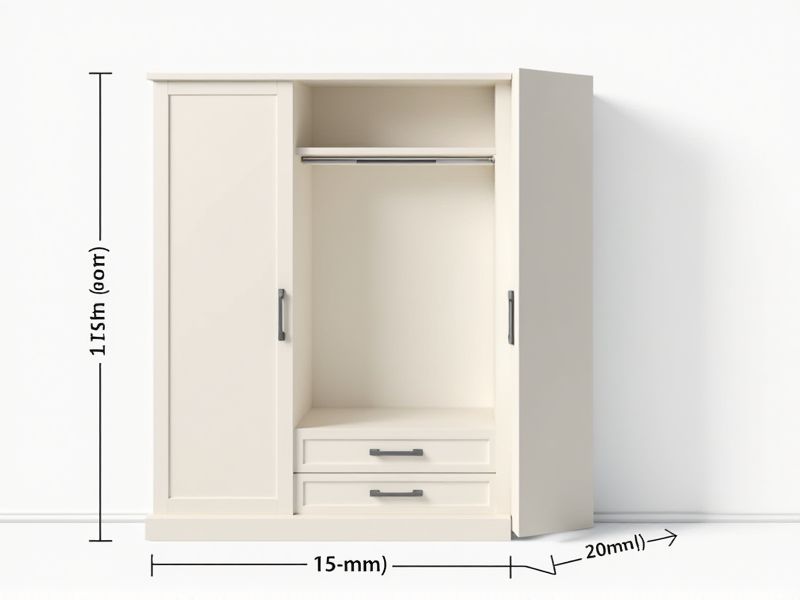
When planning for a standard closet, knowing the typical dimensions can help maximize storage and accessibility. Most reach-in closets are about 24 to 30 inches deep, which allows enough space for hanging clothes without them touching the back wall. The standard width for a single-door closet is typically at least 36 inches, but double-door or larger closets are often 48 to 72 inches wide. Standard closet height is usually around 8 feet, matching the room ceiling, which leaves ample vertical space for shelves and double hanging rods.
Width
The standard width for a typical closet ranges from 24 to 36 inches, maximizing space efficiency while ensuring accessibility. A 60-inch wide closet often accommodates double sliding doors or openings, allowing for optimized storage capabilities. For walk-in closets, widths can extend to 48 inches or more, providing ample room for shelving, hung garments, and additional organizational features. Your choice of closet width significantly impacts not only storage capacity but also the overall functionality of your living space.
Depth
The standard depth for a closet typically ranges from 24 to 30 inches, providing ample space for hanging clothes and storing accessories. This depth ensures that hangers can accommodate garments without them protruding awkwardly, allowing for efficient organization and easy access. If you are designing your own closet, consider incorporating additional shelving or drawers within this depth to maximize storage potential. Properly planning your closet's depth can enhance both functionality and aesthetics, ensuring a streamlined experience for your daily wardrobe needs.
Height
The standard height for a closet is typically between 84 to 96 inches, accommodating various storage needs effectively. This height range allows for optimal use of vertical space, making it possible to store items like seasonal clothing, accessories, and shoes efficiently. You can maximize storage by incorporating adjustable shelves within this height framework, enhancing both accessibility and organization. Investing in a closet system tailored to these dimensions can significantly improve your overall storage experience and functionality.
Rod Length
The standard rod length for a closet system typically ranges between 36 to 72 inches, allowing you to maximize vertical space efficiently. Depending on the overall height of your closet, a rod that is 48 inches can accommodate hanging clothes without creating wrinkles, while a 60-inch rod may allow for longer garments, such as dresses or coats. It's advisable to install the rod at a height of 66 to 72 inches to ensure ample clearance for hanging items. When planning your closet layout, consider the type and volume of clothing storage you require, as this will significantly influence your rod length choices.
Shelf Spacing
The standard for closet shelf spacing typically recommends a distance of 12 to 16 inches between shelves, accommodating items like folded clothing, shoes, and accessories effectively. By maintaining an average shelf height of 15 inches, you ensure maximum storage efficiency while allowing easy access to your belongings. Adjustable shelving systems can offer versatility, enabling you to customize the spacing based on your unique storage needs. For optimal organization, consider utilizing labeled bins or dividers within this standard shelf layout to keep your closet neat and functional.
Door Clearance
A standard closet typically requires a minimum door clearance of 24 inches to ensure easy access to your clothing and accessories. This clearance allows for optimal functionality, preventing obstructions when the door swings open. In many cases, slide or bi-fold doors can maximize space efficiency without compromising clearance. By adhering to these dimensions, you can enhance both the usability and aesthetic appeal of your closet space.
Hanger Space
A standard closet typically offers about 24 to 36 inches of hanging space per linear foot, accommodating various clothing types. To optimize hanger space, consider using slim velvet hangers, which can save up to 50% more space than traditional plastic hangers. Incorporating dual rods increases vertical storage, allowing you to maximize hanging space for shorter items like shirts and blouses. By efficiently organizing your closet with these strategies, you can easily access at least 30% more clothing items without sacrificing style or accessibility.
Storage Compartments
A standard closet typically includes various storage compartments designed for optimal organization and accessibility. These compartments may feature adjustable shelves, hanging rods for garments, and dedicated spaces for shoes, bags, and accessories. Utilizing vertical space, a standard closet can provide up to 50% more storage capacity when thoughtfully designed, helping you maximize every inch. Incorporating elements like drawers and bins can further enhance functionality, allowing for a customized solution to meet your specific storage needs.
Shoe Rack Space
The standard closet typically allocates approximately 12 to 18 inches of vertical space for shoe racks, accommodating about 4 to 6 pairs of shoes per shelf. A well-organized shoe rack can enhance your closet's efficiency and accessibility, allowing you to easily view and select your footwear. Many designs incorporate adjustable shelving, maximizing versatility for various shoe types, including heels, sneakers, and boots. Investing in a shoe rack can significantly transform your closet, promoting a tidy and functional space.
Drawer Dimensions
Drawer dimensions in standard closets typically range from 12 to 24 inches in depth, with a width varying from 18 to 36 inches. The height of drawers can range between 6 to 12 inches, allowing for versatile storage options. For optimal organization, it's advisable to utilize drawer dividers, especially in deeper drawers, to maximize space efficiency. When planning your closet, consider measuring the available area to determine the best fit for your personal storage needs.
